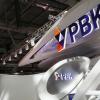The USS Freedom littoral combat ship (LCS-1) is the lead ship of the Freedom class LCS class in the US Navy.
The ship was built by the American company Lockheed Martin Corporation (LMT) headquartered in Bethesda (Maryland), USA, at the Marinette Marine shipyard located in Marinette, Wisconsin.
Keel laying took place on June 02, 2005. Launched on September 23, 2006. Handed over to the customer on September 18, 2008. November 08, 2008 introduced into the US Navy in Milwaukee (Wyoming).
Main characteristics: Full displacement 2862 tons. Length 115.3 meters, width 17.5 meters, draft 3.9 meters. Travel speed 47 knots.
Engines: 2 Rolls-Royce MT30 36 MW gas turbine engines; 2 Colt-Pielstick diesel engines; 4 Rolls-Royce water jets. The total power is 36 MW.
Cruising range 3500 miles at 18 knots. Autonomy of navigation 21 days.
Crew: 50 people of the main crew, 40 people, two interchangeable ("Gold" and "Blue" crews).
Endurance 21 days
Armament:
Anti-aircraft artillery: 1x1 57mm BAE Systems Mk 110 guns, 2x1 30mm Mk44 Bushmaster II guns.
Missile weapons: in the NETFIRES UVP anti-ship module for LAM / PAM missiles, 1 × 21 RIM-116 air defense systems.
Anti-submarine weapons: Honeywell Mark 50.
Aviation group: 1 × SH-60 Seahawk helicopter and 3 × MQ-8 Fire Scout UAVs.
September 08, 2009 completed a two-month warranty repair at Naval Base Norfolk. During the repair, along with the elimination of shortcomings, a number of systems and equipment were installed (including loading and unloading devices, equipment satellite systems communications, parts of navigation equipment and components of combat systems).
On February 17, 2010, he left the Mayport naval base and went to the first combat service, which took place in the areas of the Atlantic and Pacific coasts of Central and South America, as part of Operation SOUTHCOM.
February 22, 2010 off the coast of Colombia carried out the first interception of a speedboat carrying drugs. Nearly a quarter ton of cocaine was seized. On board, in addition to the US military, was a unit of the Panamanian security forces, taken for joint activities against drug smuggling during Operation SOUTHCOM.
In February 2011, due to severe weather conditions, a crack 0.15 meters long appeared on the ship's hull. It was later determined that this was due to a bad weld. The ship was under repair from June 27 to September 19, 2011.
On March 11, 2013, the USS Freedom (LCS-1) became the first LCS-class ship to reach Hawaii.
In November 2013, the ship delivered humanitarian aid to the Philippines affected by Typhoon Haiyan.
From April 25 to May 16, 2014 off the coast of San Diego (Southern California) unmanned and manned helicopters, in which the USS Freedom (LCS-1) took part. So, on May 12, 2014, the MQ-8B Fire Scout UAV and the SH-60R Sea Hawk manned helicopter were launched from its deck for the first time.
The construction of the floating city began in 2002.The "Ship of Freedom" has everything you need for life and recreation. After the grandiose project saw the light of day, some began to seriously argue that with the construction of a floating ship-city, a gradual relocation from land to water could begin.
The idea for the floating ship came from engineer Norman Nixon, who himself secured a license to build "a steel structure intended for civilian use." Nixon's company, Engineering Solutions, based in Florida, manages the calculations. The same company owns a factory that makes all the details of the "Ship of Freedom". Previously, the company was located in one of the cities of Japan, now it has been relocated to Saudi Arabia.
At first, Nixon planned to build just a floating recreation center, but later the project grew into a metropolis.
According to the company's calculations, the entire construction should take 40 months, and the processing of the interior - another 12 months. Thus, the floating city should enter the ocean as early as 2006.
A ship is being built in Honduras. More than 15,000 workers are involved in the construction, who work in shifts, so the work goes on around the clock.
According to the plan, the Liberty Ship should be very large: over a kilometer long and approximately 300 meters wide. It is planned to place at least 25 decks here. The weight of the floating city is 3 million tons. The record displacement of the future giant is 2.7 million tons.

According to the calculations of the creators, at least 100,000 people will “live” in the city on the water, of which 20,000 will be service personnel and a small army that will keep order on the ship.
It is planned that 80% of the residents will have their own "apartments", and the remaining 20% will rent rooms in hotels on the ship. The entire ship will represent a city similar to a populated area on land.
Despite the fact that the ship has not yet completed a single route, advertising company is in full swing - the creators accurately describe the upcoming trip and sell apartments. The owners promise that all residential premises will be completely different - each buyer can choose an apartment to his taste.

Although the ship is positioned as a city in which everyone can live, the pleasure is not cheap. The simplest apartment on Freedom Ship costs about $800,000. Although building a giant floating city is an expensive undertaking. More than $9 billion was transferred to the project, of which $22 million was spent on the erection of the construction site alone. But investors who have invested so much money in the project are confident that all these costs will pay off in full. There is no doubt about this: the ship-city has not yet been launched, and 20,000 living quarters on the Freedom Ship have already been sold (most of the buyers are residents of the British Isles).
It is believed that interest in living space will increase 10 times after the ship sails. The owners think that the demand for apartments on the ship will even exceed the supply. They are even going to arrange auctions, so that buyers will still bargain for a place on the ship.

On the Ship of Freedom, if desired, it will be possible to live without returning to land. There will be libraries, shops, cinemas, computer rooms with Internet access, colleges, universities and hospitals where qualified specialists. The decks will house banks, restaurants, casinos, swimming pools and stadiums. The company promises that the most famous people of the world will be invited to the concerts. In general, you will not be bored.
The floating city will not only have its own army, but even factories and workshops. 200 acres of "land" given over to parks, gardens and woodlands. Dog breeders will walk with their pets, which can be taken with them to the new "city", in specially designated places.
If suddenly, for some reason, someone needs to urgently go ashore, you won’t have to wait for the next stop: a small airport will be equipped on the ship.

Small trams will drive around the decks. In addition, boats and submarines will be at the disposal of the inhabitants of the ship.
In addition to the "locals", there will be more tourists on the ship. They will be placed in hotels, special excursions on the decks will be held for them.
For the whole year, the ship must make at least two cruises. Throughout the journey, the ship will stop many times near cities on land, where residents of the floating city can get on boats. Each stop will last up to 4 days.
At first, the project caused distrust among environmentalists. However, the creators promise that the floating city will be environmentally friendly: natural fibers are used in construction. On the ship itself, waste-free production will be practiced: paper, glass, metal and plastic will be recycled, and materials that are not available for recycling will be burned. The combustion energy will be used to run generators, and the water will circulate around. Everywhere there will be electrostatic filters that destroy dust, bacteria and viruses.

It goes without saying that the giant ship project also has opponents. In particular, many believe that the "Ship of Freedom" can repeat the fate of the "Titanic", which at one time was also advertised as an unsinkable city on the water. The fact is that the basis of the "Ship of Freedom" is the technology used on floating oil rigs. It is considered reliable, but these towers do not swim at high speed, but are in one place. True, the ship's designers say that everything is precisely calculated. Even if the supporting elements fail, the ship will sink no deeper than one foot into the water. Repair work will be carried out immediately, so there is nothing to worry about. The owners even note that the “Ship of Freedom” will be almost the most reliable place on our earth. After all, he is not at all afraid of fires - powerful sprayers are placed throughout the area, and the staff includes its own firefighters. In addition, the ship is equipped with a stabilization system that allows you not to worry about strong ocean waves and hurricanes at all.

Some opponents of the Liberty Ship project say that once this floating city is cut off from land, absolute anarchy can be established here. The company has the opposite opinion on this: there will be one security guard for every fifteen passengers, all apartments will be monitored around the clock, and there will be a private prison on board. Mike Bluestone, a London-based security consultant, claims that it will be even harder for criminals on a ship than on land, since there is no chance of hiding in a floating city - everything is in plain sight.
The floating city project has many defenders. Firstly, theoretically it is beneficial, since the ship will sail almost all over the globe, here anyone can safely do business. Living in a ship-city, you do not need to pay any taxes (and people on the ship can work, that is, have an income), which becomes very attractive for many businessmen. Secondly, the best conditions are created on the ship. The owners even say that perhaps some people will live on the ship for more than one year. Consequently, the "Ship of Freedom" can be considered an attempt to test the water surface as a new habitat.

Nixon has repeatedly said that if the city-ship becomes popular, then later it can be transformed into a floating state, with its own symbols, flag, anthem, currency, where you can elect your president and create your own constitution.
While disputes are ongoing over which country the "Ship of Freedom" will obey. The owners of the company note that it will definitely not be the United States, most likely, the ship will sail immediately under the flags of two European countries, which ones are still being decided.
The owners of Freedom Ship themselves do not doubt their success. Despite the fact that the first ship-city has not yet been launched, there is already talk that by 2010 another 5 such floating cities will be built.







P.S. December 4, 2013.
Freedom Ship International announced the resumption of the project to build a "floating city". We are talking about the largest ship in the world, on which up to 50 thousand people can live. Work will begin after the authors of the idea manage to find at least $ 1 billion.
The 21st century opened with an ongoing secret rivalry among the major nations to build the perfect sea view. military equipment. Not the last word here belongs to the designers from the North American States, who are commissioned by the US Navy in the construction of ships.
Recently, in America, a coastal zone ship (CPS) of the new generation Independene was designed, assembled on factory slipways and passed sea trials - the lead ship of type II, created according to the LCS project (coastal ships operating in shallow water areas). The tests carried out identified a number of serious errors of military shipbuilders.
Project LCS
The project to create LCS (coastal ships operating in shallow water areas) is currently considered the main task of the US Navy to be urgently implemented, requiring the immediate commissioning of more than 50 high-speed and maneuverable local-based ships, which are equipped with shock, defensive weapons and radio equipment, created with the latest technology. They are designed to conduct local combat operations in coastal waters.
The "father" of this idea and the "generator" of subsequent actions was the head of the Naval Operations Department of the US Navy Headquarters, Admiral Vernier Clark. The position of the admiral is such that littoral ships are needed where there is no point in using ocean-type ships for tactical or financial reasons.
Littoral zones
This implies the conduct of hostilities in the area of shallow depths. However, in the Russian naval literature, and in the established practice of the actions of the Russian Navy, such a term is used somewhat in a figurative sense. Littoral - the area of the bottom of the sea or ocean, subject to flooding at high tide and the formation of shallows at low tide. From the standpoint of the tactics of the Navy in the "classic" - this is a very small area in order to control the situation in it to build new class ships. Western naval strategists define the littoral zone as the area of intersection of the water element and the coast, which includes the sea coast, coast line, coastal slope, which is under water. In their concept, all these objects can reach a width of several meters to several kilometers. In Russian naval theory, this part of the water area is referred to as the "coastal sea zone" (from the English "litoral" - coastal).
Therefore, from our point of view, US Navy ships of the Independene and Freedom types must be considered from the standpoint of the tactics of the ships of the near sea zone.

The concept of actions of ships of the near sea zone
As American military strategists think, the concept of using ships of the near sea zone is quite simple and is located in just two main directories.
The first is the intended use. This application is against surface small and medium ships, small submarines, coastal artillery, mine mobile and stationary systems. Thus, to perform these combat missions, it is necessary to create a DD (X) class warship, which, if necessary, could operate in the second directory, up to being used as an landing ship for special forces units or serve as a base ship for launching cruise missiles .. Such a wide the range of capabilities of the littoral ship implies its rapid transformation into the type of watercraft that will be necessary to complete the assigned combat mission.
A feature of the creation of such ships was the principle of modular assembly with an embedded version of the so-called. "open type architecture", which makes it possible to apply the latest construction technologies on a par with modern building materials.

Tender for the creation of littoral ships
Interest in this project 6 companies showed, as a result of the selection conducted by the US Navy commission, three applicants remained: Dynamics, Lockheed, Raytheon - well-known firms in the USA. Each concern received a contract, Dynamics for 9 million dollars, the rest of the whales of the military industry - for 10 million dollars. A year later, sketches of littoral ships were submitted to the commission for consideration.
The Dynamics project involved the development warship trimaran type. The advantages of this type of ship, along with high seaworthiness, were high speed (over 50 knots) and the operation of the ship with a small crew of about 25 people. As conceived by the creators, it is designed to solve problems for:
- combating sea pirates and terrorists
- countering coast guard boats, even when attacking in a deployed manner
- organization of search activities and destruction of enemy submarines located in the coastal zone
- conducting mine action
- rendering assistance to other ships
The Lockheed project involved the development and use in the construction of the ship's hull under the name "sea blade", the op was a variant of combining the classic forms of the ship with the variant of the "glider" type. This form of construction was used by semi-sport high-speed vessels that set speed records in transatlantic crossings. To achieve success in accepting an order by naval sailors, Lockheed designers fulfilled all the requirements of the customer, especially the conditions for interchangeability and versatility, while putting modular equipment on their sample.
And lastly, the Raytheon project proposed a solution to the problem of creating a littoral ship based on the Skjold small missile boat (Norway). Here, the Raytheon concern was responsible for the creation, implementation and interaction of the ship's systems, and the ship's hull construction project was carried out by another specialized engineering group. This project was different in that the boat was created on an air cushion, so it did not fit the US Navy.
Use of other ship types
While the military department and legislators were dealing with paperwork, preparing for the launch of the littoral ship program, the maritime leadership tested various options for using modular systems on non-traditional types of ships.
One of the options for experimental use was a ship with a small waterline area called "Sea Fighter", which operates confidently in various extreme situations. One of the main requirements for developers when using the base of this ship was to be a modular system for completing the ship, and such a ship should serve as a base for receiving / landing helicopters, as well as “small”, incl. and "automatic drones". The ship was launched in early June 2003 for sea trials. At the end of the month, having shown its best side, the ship was commissioned into the US Navy.

Tactical characteristics of "Sea Fighter"
Displacement -950 tons.
Length - 80 m.
Width - 22 m
Draft - 3.5 m
Sea crossing range -4400 miles
Crew -26 people.
The power unit is combined, the gas power plant includes 2 diesel engines MTU 595 and 2 gas turbine engines LM 2500
The rest of the Sea Fighter equipment
2 swivel "water cannons" are used as ship propellers, located one in each catamaran hull. With the synchronous operation of all units of the ship, the speed of the ship reaches 50 knots.
The ship is equipped with 2 decks for landing helicopters, at the stern there is a receiving-output device for various underwater and surface automated and other vehicles that solve a wide range of tasks, from reconnaissance and sabotage to mine action.

Appointment and testing of the ship
A ship with a small waterline area, the Sea Fighter is designed to solve two main problems. This is the study of real internal resources such a system of ships and the launch of a system for the modular construction of sea vessels, including in the acquisition of weapons. It was planned to use the so-called. container variant of completing ship's superstructures according to the principle of a block diagram of electronic devices. In addition, each container represents an electronic complex various kinds opposition to the enemy.
Initial tests of the Sea Fighter immediately gave positive results. The results of the experiments were taken into account in the program for the development of both types of LCS. Recently, the leadership of the US Navy has been actively investigating the issue of the participation of Sea Fighter-type ships in planned operations, both by the US Navy, and the use of these ships in areas of America's economic interests and in solving issues related to US internal problems in the water. With the operational expediency of the rapid movement of troops with the help of such ships, the wax is moved to the zones of national interests of the United States.
Test results
In February 2004 supervisory authority The US Congress as a whole approved the project submitted by the US Navy on the feasibility of acquiring ships of the coastal zone for the needs of the US Navy. In May of the same year, the US Navy Department announced the results of a tender, according to which the Dynamics and Lockheed concerns received contracts worth about 80 million and 47 million dollars, respectively. Dynamics will build ships codenamed LCS 2 and LCS4, while Lockheed will build ships codenamed LCS 1 and LCS3. The total cost of contracts for the construction of all ships will be 540 and 425 million dollars, respectively. In general, the Americans are ready to spend more than 4 billion dollars on the construction of all ships of this type.

In early June 2005, the construction of the lead littoral ship of the LCS 1 Freedom type began, built in 2006. In November 2008, he was commissioned into the US Navy.
In January 2006, Dynamics began construction at the shipyard of the trimaran Inderpendence, in April 2008 its construction was completed and in January 2010 it was raised naval ensign US fleet.

After that, the coastal ship building program was curtailed. Initially, the reasons for the increase in prices under the contract were called, later the programs were closed due to lack of funding by the US Congress.
The hardly built littoral ships LCS3 and LCS4 by Dynamics and Lockheed showed unsatisfactory results during dynamic tests, many defects and malfunctions were revealed.
Captain 1st rank V. Spirin,
captain 2nd rank D. Vasilevsky,
captain-lieutenant E. Leonov
B outlined the background to the Program for the creation of multi-purpose ships of the coastal sea zone for the American fleet - frigates (FR) of the LCS class, which was preceded in the mid-90s of the last century and in the early 2000s by two others - the "Surface Ship of the 21st Century" (SC-21 ) and "Surface Ship of the Future" (FSC) for the construction of destroyers and URO cruisers, respectively. However, due to severe cost savings and cuts in the Navy's budget, they were curtailed or only partially implemented.
Foreign media also paid attention to the last program (LCS) due to the extremely high cost of the project, numerous design problems, and inconsistencies during construction, especially at the initial stage. Foreign experts express concern about the low survivability of the ship, its weak armament, etc.
First of all, readers may be interested in the analysis of the cost of the program at various stages of its implementation, carried out by the authors of the article, as well as the strategy of the leadership of the Maritime Ministry to acquire
Basic LCS projects
This project, which involves the construction of the first 24 ships, is known as the LCS mod. 0+. However, two of them were built according to the previous one - LCS mod. 0, which differs little from the last one.
| The basic design of the Freedom-type frigate (LCS-1) of the Lockheed-Martin company: 1 - aft ramp for launching and receiving delivery vehicles; 2 - runway; 3 - compartment for accommodating payload modules; 4 - anti-aircraft missile system RAM; 5 - hangar; 6 - 30-mm artillery mount Mk 50; 7 - radar; 8 - GKP; 9 - 57-mm artillery mount Mk 110; 16 - crew cabins; 11 - gas turbine plant MT30; 12 - diesel engines; 13 - main reduction gears; 14 - jet propulsion |
 |
| The basic design of the Independence-class frigate (LCS-2) by General Dynamics: 1 - system for launching and receiving delivery vehicles; 2 - runway for two H-60 helicopters or one H-53; 3 - compartment for accommodating payload modules; 4 - SAM "Si RAM"; 5 - hangar for two H-60 helicopters; 6 - antenna devices of radio electronic means; 7-bow 57 mm - AU; 8 - GAS mine detection; 9 - wheelhouse; 10 - crew cabins; 11 - compartment elevator for accommodating payload modules; 12 - auxiliary equipment of the payload module (containers, standard interface systems, hardware); 13 - ramp for loading the payload; 14 - two 12.7-mm aft machine guns of the left and right sides |
The base LCS is a relatively inexpensive ship. Unlike other multi-purpose ships with their inherent capabilities, it was conceived as a ship with interchangeable weapon modules and REV, including uninhabited underwater vehicles (UUVs). One functional module in a short time can be replaced by another depending on the task in order to solve it as efficiently as possible. Such an approach, according to foreign experts, is the most promising, given that equipment and weapons, as practice shows, become obsolete faster than the established life of ships ends.
It is assumed that the main tasks of LCS-type frigates will be solved in the coastal zone - combating low-noise diesel-electric submarines, conducting mine action, combating high-speed boats, including those operating in large groups. They may also be involved in reconnaissance, ensuring the safety of navigation (including the fight against terrorism and piracy), supporting operations conducted by marines and forces of special operations, protection of territorial waters. Secondary tasks LCS can perform without the use of special weapon modules and REV, however, some of them can be more effectively solved only with their help.
The displacement of the LCS is about 3000 tons, which is more in line with the characteristics of a corvette (or light frigate), as well as a coast guard ship. The full speed is more than 40 knots, which exceeds that of the US Navy's CR URO and EM URO by an average of 10 knots. A small draft in comparison with them allows the FR to operate in shallow water in the immediate vicinity of the enemy's coast and use ports with shallow depth.
Friedam-class frigates (LCS-1)
The lead ship of Lockheed Martin, Freedom (LCS-1), was laid down on June 2, 2005, launched on September 23, 2006, and commissioned into the US Navy on November 8, 2008. In February 2010, he went on his first campaign, which took place 2 years later than planned.
The hull of the ship - semi-planing type - provides high seaworthiness. It is made of steel. The superstructure is made of aluminum alloy. When designing the ship, the "stealth" technology was widely used.
Equipment for FR "Freedom" was purchased, including in European countries. Its combined diesel-gas turbine power plant includes two MT-30 gas turbines manufactured by Rolls-Royce (Great Britain), two diesel engines jointly produced by Fairbanks Mors and Colt-Pilstick 16PA6BSTC, as well as four reduction gears MAAG (Switzerland).
To ensure the survivability of gas turbine engines are located in different compartments on board. The main reduction gear (GRP) and diesel engines (DTs) are located in the following two compartments of the main mechanisms from the left and right sides separately from the gas turbine engine. Reduction gears are located in the compartments of auxiliary mechanisms, following aft from the compartments of the main mechanisms, also on board.
The main engines of the port and starboard sides work on the hydraulic fracturing of the left and starboard sides. Further, the energy is transferred along the lines of the shaft to the reduction gears of the left and right sides, which set in motion two groups of propellers. Each group includes two jet propulsion units: with an adjustable jet direction and an accelerating one. There are no rudders on the ship. The change of course is carried out by means of jet propulsion with a controlled direction of the jet stream.
The power plant is combined, with the joint operation of marching diesel and afterburner gas turbine engines at full speed. The power of the power plant is about 100 thousand liters. With. The EPS of the ship includes four electric power generators driven by a DD manufactured by Isotta Fraschini, brand V1708. The GEM control and protection system was developed by DRS Technologies (USA). Four water cannons of the SII series of the Kameva company, which is part of the Rolls-Royce company, were chosen as the mover. The chosen architecture of the hull and the layout of the main power plant make it possible to reach speeds of more than 40 knots and provide high maneuverability.
ship weapon
 |
| Placement of weapons on the frigate of the type "Freedom" |
The Freedom-class frigate's armament includes the RAM Mk 31 air defense system with Mk 49 launchers developed by Raytheon and the 57-mm Mk110 gun manufactured by United Defense (USA), which can hit targets at ranges up to 17 km. Also, on the side in the bow of the superstructure, platforms are provided for large-caliber 12.7-mm machine guns. Two more will be located in the runway area.
In addition, the ship of the Freedom type will be based on the MH-60R or MH-60S mod. 2A (B), as well as two unmanned aerial vehicles (UAVs) MQ-8B Firescout. The UAV is equipped with television cameras, an infrared detection system, a laser range finder, data transmission equipment, a Synthetic Aperture Radar "Lynx", and may also have EW, RTR and relay equipment. "Firescout" provides reconnaissance to a depth of more than 200 km (radius). In the MQ-8B variant, it can be armed with Stinger, Hellfire air-to-air guided missiles, as well as Lokaas or Viper Strike submunitions.
Takeoff and landing system aircraft developed by "Mac Taggart Scott" (Great Britain). The runway area (RWY) is 1.7 times larger than that of the O. Burke-class destroyers and 1.5 times that of the Perry-class URO frigates.
Places are provided in the aft part of the superstructure, and under the hangar and the runway there is a compartment where interchangeable payload modules with weapons and systems that ensure their functioning will be placed. Depending on the nature of the tasks performed, these can be: 30-mm AU Mk 46, towed antennas of the 2087 sonar complex, helicopters, unmanned aerial vehicles and anti-mine uninhabited underwater vehicles, launching devices for boats (including without crew type "Spartan") , as well as other systems that are part of the payload modules.
Electronic weapons
The ship is equipped with a TRS-3D radar station (EADS, Germany), which can automatically detect and track up to 300 air and surface targets.
Also, the composition of radio-electronic equipment will include automated system combat control COMBATSS-21 (Lockheed Martin and Raytheon, USA) and a jamming and decoy system (Therma, Denmark).
Independence-class frigates (LCS-2)
The second hull of this ship was planned to be completed in April 2008, but this actually happened in December 2009. Introduced into the combat strength of the FR on January 16, 2010.
 |
| Schematic diagram of the power plant of the frigate of the "Independence" type (LCS-2): 1 - jet propulsion with a changeable direction of the jet stream; 2 - reduction gear; 3 - waterproof bulkhead; 4-piece coupling; 5 - diesel engine; 6 - plumbing; 7 - reduction gear; 8 - gas turbine engine |
 |
| Placement of weapons on the Independence-class frigate (LCS-2) |
 |
| The composition of weapons and electronic weapons LCS-2 of the basic project of the Independence-class frigate (LCS-2) of the General Dynamics company: 1 - system for launching and receiving delivery vehicles; 2 - landing area for two MN-60 helicopters or one MN-53; 3 - hangar for two MH-60 helicopters; 4 - SAM SeaRAM; 5 - placement of radio electronic equipment on the mast (a - antenna of the satellite communication system (3-30 GHz); b, n - antennas of the satellite communication system (0.3-3 GHz); c, d - antenna of the communication system (range 3-30 MHz); e - infrared communication system sensor; e - communication system antenna (range 30-3000 MHz and 10-300 MHz); g - antenna of the JTIDS tactical information distribution system; h - PPTP system antenna; and - antenna of the AN PN communication system / SQR-4; k - optoelectronic system; l - radar antenna for detecting air / surface targets "Sea Giraffe"; m - antenna of the SINCGARS radio communication system (30-300 MHz); o - navigation radar antenna; p - camera of the video surveillance system; p - searchlight; c - antenna of the INMARSAT satellite communication system); 6 - bow 57-mm AU; 7 - GAS mine detection; 8 - two 12.7-mm machine guns on the left and right sides; 9 - PU systems for setting false targets SRBOC; 10 - PU system for setting false targets "Nulka"; 11 - two stern 12.7-mm machine guns on the left and right sides; 12 - anti-torpedo defense system |
During the construction of the Independence-class frigate (LCS-2), General Dynamics paid considerable attention to increasing its speed. Large-scale studies were carried out to determine the optimal contours of the hulls with improved hydrodynamic characteristics.
All LCS-type frigates of General Dynamics will be built at the Austal U.S.A. shipbuilding yard. The following companies are involved in the creation of this ship: General Dynamics Advanced Information Systems of Orlington; "Arma-ment and technical product"; "Electric Boat Division"; General Dynamics Canada; SAE of Leesburg; "Bi-I-I systems"; Maritime Applied Physics, and Northrop-Grumman Electronic Systems. As in the Lockheed Martin LCS-1 project, steel was chosen for the manufacture of the ship's hull, and aluminum alloys for the superstructures.
When creating the Independence trimaran, the project of a passenger-and-freight ferry of the Australian company Austal was taken as a basis. The selected architectural and structural type provides improved seaworthiness and increased ship capacity. Thus, the area of the helipad and hangar (about 1,450 m2) is almost 2 times larger than that of the Freedom-type LCS. This allows you to place on it two medium helicopters MH-60R / S and up to three UAVs MQ-8В "Firescout" at the same time (on the LCS of the "Freedom" type, UAVs can only be instead of one of the two helicopters).
Ship power plant
The composition of the main power plant of ships of the Independence type includes: two GTE LM2500 manufactured by General Electric with a total capacity of 52,500 hp. With; two 20-cylinder V-shaped diesel engines of the MTU brand 20V 8000 with a total capacity of 22,298 liters. With; four jet propulsion units with variable jet direction of the LJ-E series, developed by Vartsila-Lips. To improve the maneuverability of the ship during mooring, a thruster is used. All power plant units are located in the middle hull of the trimaran - in compartments separated by watertight bulkheads. This installation layout and hull architecture will allow the LCS to achieve a full speed of over 40 knots.
Ship armament
The armament includes: 57-mm AU Mk 110 (in the bow of the ship), SeaRAM air defense system (above the hangar), as well as four 12.7-mm machine guns (on the left and right sides).
The armament of the FR will also include various modules for solving the problems of PM and ASW, combating high-speed small-sized surface targets. Weapon modules include a sonar system, helicopters, unmanned aerial vehicles and uninhabited underwater vehicles in a mine or anti-submarine version, and a number of other systems.
Upgraded LCS project (for the last 12 ships, from LCS-33 to - 44).
After analyzing the possible threats to the theater until 2025, the command of the US Navy put forward additional requirements for an improved project, which is planned to be used to build the last 12 units in the series. Despite the fact that work on the creation of ships of the basic project continues, there are plans for their phased modernization.
Beginning in fiscal year 2017, this project must include additional technical means(stationary, not replaceable modules) or improved existing ones to combat high-speed small-sized surface targets, enemy diesel-electric submarines, as well as to provide air defense. In addition, the visibility and resistance of the ship to combat damage should be reduced. Its displacement, apparently, will increase slightly, and the full speed will decrease.
To compensate for these negative aspects, it is proposed to reduce the mass of a number of ship systems, and above all, to reduce the area of compartments for accommodating payloads (previously reserved for weapon modules and REV) compared to the base project. In this regard, it is not expected to use the last 12 ships for PMO, and their main tasks will be: the fight against high-speed small-sized surface targets and low-noise diesel-electric submarines in shallow water. In addition, the upgraded LCS will be able to perform secondary tasks inherent in ships built according to the basic design.
According to preliminary estimates, the increase in LCS capabilities will not lead to an increase in the purchase price by more than 20%
Thus, the modernization of the existing basic LCS project will be carried out in the following areas:
- installation of a modernized three-coordinate OVTs radar;
- building up the ship's air defense capabilities, including the SeaRAM air defense system;
- installation of additional anti-ship missiles (ASM) to combat small-sized high-speed surface targets;
In 2003, the construction of a floating city will be completed, whose citizens may never go ashore, but will be provided with everything necessary. According to forecasts, this colossal ship will begin a new era of navigation and the era of relocation from land to water.
It seems that the multi-billion population of our planet is ripe for the development of the oceanic expanses.
This, without exaggeration, the eighth wonder of the world was called corny and sparingly: Freedom Ship (“Ship of Freedom”). This is the working name, which, apparently, will be given to the ship. Although old and superstitious people recommend being more modest and naming the ship after Poseidon, for example, reminding the sprawling shipbuilders of the history of the unsinkable Titanic. But who will listen to people from the past if the project is fully and completely turned to the future?
So, facts and nothing but facts. The Freedom Ship will have 25 decks and be over a kilometer long and approximately 300 meters wide. Displacement - 2.7 million tons (for comparison: the displacement of the largest supertanker on the planet - Jahre Viking - 564.739 tons). The weight of the floating city is 3 million tons.
About 70 thousand people will be permanently on board, of which 50 thousand are "islanders" who own real estate on the ship, and 20-25 thousand personnel, including the security service and a small army.
In addition, there may be tourists on board who will live in hotels. In total, more than one hundred thousand (100,000) people can sit on the Freedom Ship without any hesitation. This is comparable to the population of, for example, Reykjavik. Or two Gorno-Altaisks, for example.
Despite the fact that the ship has not yet been put on the water, its creators hastened to tell the public about the upcoming routes.
The cost of the project is $9 billion, and $22 million has already been allocated to equip the construction area alone. To date, 20,000 residential apartments have already been sold, each costing from 80,000 to 6 million pounds (the average price in dollars is $800,000). Most of the future tenants are citizens of Europe (including the British Isles).
According to the advert for the floating city website, there are at least 50 architectural and design styles for living spaces. There will be a library, a university, computer rooms with Internet access, a college with in-depth study of engineering, medicine and all kinds of sciences, a hospital.
Plus banks, restaurants, stadiums, casinos, courts, swimming pools, hotels, several businesses (light and processing industry, shops and workshops), and, of course, the airport. In addition, 200 acres of “land” have been allocated for parks, gardens and woodlands, where dog breeders will walk with their pets.
Modified trolleybuses, trams and other rail vehicles will travel on board. In addition, the citizens of the ship have at their disposal small planes, pleasure submarines, boats and ferries. Plus hangars and harbors for boats.

The magnificent white liner should be a haven for the wanted by the tax police.
So, the work schedule is as follows: the floating island will make round-the-world cruises every two years, call at ports where local residents will board, who will be allowed to use the benefits of the “Freedom Ship” - buy goods, for example, and so on. Meanwhile, citizens who are not involved in trade can inspect the surroundings, take pictures of wild monkeys and local grimy children.
During the stops, which will last from one to four days, boats will depart every half an hour to the shore and back - the ship itself will stand in the open sea, at a distance of 12 miles, and will almost never enter the port waters.
The Floating Island will be far more environmentally friendly than any other vessel in existence. To do this, the ship will use high-tech toilets (the cost of each is $ 3 thousand), processing wastewater. Water will circulate in a circle: after consumption (for example, washing) it will be able to return to the table as drinking water.
The ship will recycle (recycle) paper, glass, metal and plastic. Materials not available for recycling will be incinerated and the energy from the combustion will be used to run generators. Water-based paints, natural fibers and natural wood are already being used in construction. In addition, the use of plastics and petroleum-based materials is reduced as much as possible. Everywhere there will be electrostatic filters that destroy dust, bacteria and viruses.
The ship is being built in Honduras. According to the plan, it will be assembled on the water from 600 steel fragments. It is planned to attract 15,000 workers to the construction, who will work almost around the clock - in several shifts.
The king and God, the author of the idea and its developer, the head of the team is an ordinary architect and engineer Norman L. Nixon, who in order to start building a city in the ocean, it was enough to get a “license for the development and construction of structures intended for civilians."
All calculations are carried out by Nixon's company, located in Sarasota, Florida - "Engineering Solutions" ("Engineering Solutions"). The main supplier of materials for the construction of the "water world" is a plant recently dismantled in Japan and assembled in Saudi Arabia, which is also owned by the company.

The technology to keep this thing afloat is already widely used on floating oil rigs, Nixon said. True, what speed do these towers develop? The "ship fathers" say that if 98 percent of the outer modules that make up the city fail, the ship will sink no deeper than one foot into the water.
In addition, "it is known for certain" that the ship will be able to withstand any hurricane and waves, as well as tornadoes and other maritime troubles. Not a word about the tsunami ... But "Freedom" is a ship "practically fireproof", as it is equipped automatic system sprinklers (sprayers).
According to Nixon's calculations, the construction will take 40 months, including assembly at sea, plus at least a year to equip and build the "innards" of the ship. According to the engineer, at first there was an idea to build an ordinary floating house, not intended for travel. And they even chose a "mooring place" - one of the Bahamas - East Caicos. We thought it would be an ordinary hotel afloat - exotic and fun.
However, now everything is much more serious. Oddly enough, the size in this project is not of the greatest importance. Firstly, "Freedom Ship" is a duty-free territory and a free trade zone, and the meaning of the existence of its citizens is to engage in small commerce, to establish business connections Worldwide.
Secondly, it is an experiment to create a new type of society in new conditions. "Novelty" is made up of two factors: the lack of tax collection on the ship and the inability to escape from the ship. Thirdly, this is an attempt to test the water surface as a new habitat - to identify the pros and cons of living on board. Fourthly, this is a completely anti-American project, although one can argue on this point.
The most interesting thing is, of course, point two: taxes and security. Not a single citizen of the ship will pay any income tax (and they will work there, respectively - have an income), or tax on real estate, on sales, on animals, or duties - in general, no taxes.
Now about agoraphobia (fear of open spaces), claustrophobia (fear of enclosed spaces) and crime. From the point of view of the residents who think they have "broke free", the name of the ship will sound somewhat ironic and ominous. There will be one security guard for every fifteen passengers, every apartment will be monitored around the clock, there will be a prison on board, and the captain will have almost unlimited powers, the police will be armed with firearms, and so on.
In addition, something like an intelligence unit will operate on board, and against the backdrop of the fight against terrorism, it is possible that security measures will be tightened.
Mike Bluestone, a London-based security consultant, oversees the establishment of the security structure. According to him, everything will be the same here as in an ordinary, “ground” city - petty hooligans, thieves, divorces, quarrels and lawsuits between neighbors. People are people. But - in any case - the consequences of small riots in the ocean can be more unpleasant than on land.
On the other hand, to completely deprive people of the opportunity to live a normal life means to question the very idea of \u200b\u200bFreedom. Another problem is the possibility of an attack on a ship during a round-the-world cruise. As we wrote above, on the floating island there will be a small army that will be able to "resist the terrorists" and repel the attack of the pirates.
Another point of view belongs to the more skeptical Ivan Horrocks (this is a security specialist from the University of Leicester - Scarman Center at the University of Leicester). He believes that the cosmopolitanism of the island’s citizens can play a cruel joke with the organizers of the eighth wonder of the world: “When you create an artificial environment in which you place people with different ethnic, cultural, political ideas and attitudes, the likelihood of a tense situation is sharply increased. “flight the ship.” Horrocks continues to let out “horror”, saying that it will no longer be a utopia, but a dystopia.
The darkest question, which is not clearly explained anywhere, is the citizenship of the inhabitants of the ship. Nixon himself says that at first he had the idea of creating an independent water state - with its own symbols, flag-anthem, currency, and so on, but he "came to the conclusion that it was not only difficult, but also unprofitable - too many formalities" . This idea has become even more meaningless against the background of the fact that the majority of the "settlers" are Europeans, and many European countries want to be associated with the "Freedom Ship" - there are both political and economic overtones here.
In general, it is not yet clear which country will patronize the ship. Nixon made a Solomonic decision: the ship would sail under at least two European flags and in no case would become subordinate to the United States. Moreover, these countries must certainly be members of the European Union. This is despite the fact that Nixon's company is located in Florida. What is it?
And now about "anti-Americanism". Parts are produced in Saudi Arabia, construction is carried out in Honduras, and on board are entirely Europeans. One far-reaching political conclusion can be drawn from this: MacDonald's will not be on board.
Nixon decided that the highest authority in the floating city was the captain, who could make his own laws. But the laws must not contradict the laws of the countries exercising control over the ship and taking the ship under their jurisdiction.
The fact that all of the above is not the madness of a single engineer is evidenced by the fact that now in Japan, in the waters of Tokyo Bay, the construction of a floating mega-airport begins, which, similarly, will have a kilometer in length and 70 meters in width.
The designers of Freedom Ship, in turn, are so confident in the success of the project that they are seriously planning to build - having already “filled their hand” - three more of the same “floating cities”. According to Roger Gooch, marketing director of Freedom Ship, floating ships are not just exotic housing for extreme sports lovers - they are housing of the future, and very soon - in ten years - twenty hundred such floating inhabited islands will surf the ocean.

Sea Structures Corporation is betting on artificial islands.
Nixon also has a competitor - Richard Morris of the Free Nation Foundation, the founder of Sea Structures Corporation, where they also plan to build something similar. But, you understand, in such cases there is the first and all the others. Gagarin and everyone after him.
Paying tribute to the ingenuity of the engineer, the lack of patriotism in him, and also realizing that the idea was up in the air, we still tend to consider the venture with this particular "Gorno-Altai" adventure. And here are the reasons. First, the most obvious sign that you are being swindled is that you cannot see the face of the person who is doing it. Honesty is the best policy, and Nixon's photographs are, alas, impossible to find.
The second sign is excessive detail in the details, including the route map, while withholding technical data: what is the ship made of, for what reason is it called unsinkable? The data that a 100-foot wave can only move a floating city by one inch is certainly impressive, but it looks a lot like chatter. Or take at least reflections on the psychological compatibility of the inhabitants. The question, of course, is not idle. But now it is somehow, at least, not serious to conduct surveys of psychologists-sociologists on this topic.
Thirdly, something has not been heard for a long time "news from the fields." The announcement about 2003 was made a few years ago, and now there is silence. Were there no sponsors? Or, God forbid, what happened to Nixon himself? In general, silence. And so it's a good idea.
Indeed, why don't people start exploring the ocean? Could this really be an opportunity to solve the problem of overpopulation? And if it’s not Nixon, then there will be another Prometheus, and then another and another ... The idea is, in fact, great! And promising.














